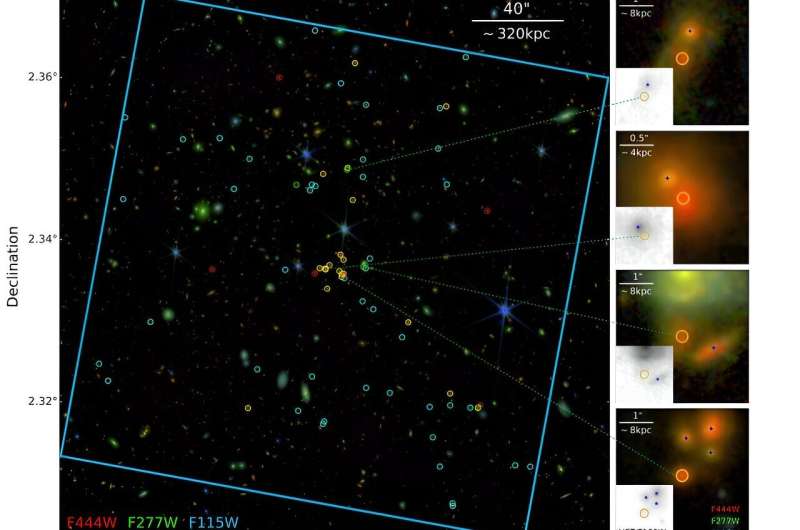March 18, 2024 report
This article has been reviewed according to Science X's editorial process and policies. Editors have highlighted the following attributes while ensuring the content's credibility:
fact-checked
preprint
trusted source
proofread
JWST observations shed more light on the nature of a distant galaxy cluster

Astronomers from the Nanjing University in China and elsewhere have performed high-resolution observations of a distant galaxy cluster known as CL J1001+0220 using the James Webb Space Telescope (JWST). The observational campaign, described in a paper published March 8 on the preprint server arXiv, yields important information regarding the nature of this cluster.
Galaxy clusters contain up to thousands of galaxies bound together by gravity. They are the largest known gravitationally bound structures in the universe, and could serve as excellent laboratories for studying galaxy evolution and cosmology.
CL J1001+0220 (or CL J1001 for short) is a galaxy cluster in the constellation Sextans, containing 17 galaxies, located at a distance of some 11.1 billion light years. It has an enhanced star formation rate (SFR), short gas depletion time and showcases strong evidence that the properties of its member galaxies are affected by the extreme environment.
Previous studies have found that J1001 appears to be undergoing the transformation from a protocluster, to a mature cluster. Given that such evolution is not fully understood, a team of astronomers led by Nanjing University's Hanwen Sun, decided to take a closer look at this process using JWST's Near Infrared Camera (NIRCam). Their study was complemented by data from ground-based telescopes like the Subaru Telescope and the Atacama Large Millimeter/submillimeter Array (ALMA).
"Here we present new JWST/NIRCam observations targeting the distant cluster CL J1001 at z = 2.51 from the COSMOS-Webb program, which, in combination with previous narrow-band imaging targeting Hα-emitters and deep millimeter surveys of CO-emitters, provide a complete view of massive galaxy assembly in CL J1001," the researchers wrote in the paper.
Sun's team managed to complete a census of CL J1001's member galaxies. First, they identified a population of red and massive cluster members, which have been missed from previous deep imaging using the Hubble Space Telescope (HST). This confirms that JWST observations are necessary in order to obtain a full census of members in galaxy clusters.
The study found that the spatial distribution of member galaxies in CL J1001 is highly concentrated. The astronomers noted that the central stellar density of CL J1001 is comparable or even higher than more massive low-redshift clusters, contrary to what is observed in the outskirts of this cluster. These findings suggest an inside-out formation scenario for the earliest clusters known.
Furthermore, based on the mass-complete sample of star-forming members, the astronomers found that the stellar mass function of CL J1001 shows a prominent "top-heavy" feature—as there is an overabundance of massive star-forming galaxies (SFGs) piled up in the cluster core. It turned out that the total number and stellar density of these massive SFG members are comparable to that of massive SFG and quiescent galaxies combined in clusters at lower redshifts.
Summing up the results, the authors of the paper concluded that CL J1001 is currently in a rapid transition and many of its massive SFGs will likely soon become quiescent.
More information: Hanwen Sun et al, JWST's first glimpses of a z > 2 forming cluster reveals a top-heavy stellar mass function, arXiv (2024). DOI: 10.48550/arxiv.2403.05248
Journal information: arXiv
© 2024 Science X Network





















